How to Get Graphic Design Clients Right Now: 5 Amazing Tactics That Work
Freelancing offers graphic designers immense freedom and flexibility to be their boss and build their brand. However, the unpredictability of freelancing can also be a challenge. While over 90% of graphic designers are freelancers, many need help with inconsistencies in new client acquisition. Once a project ends, they scramble to fill their schedule with the next one. This client hunting leaves little time for meaningful creative work.
So, how can freelance graphic designers bring in a steady stream of new clients without getting overwhelmed? The key is implementing scalable and automated marketing strategies. Instead of starting from scratch each time, savvy freelancers implement systems to attract ideal new clients regularly.
Five marketing methods that have proven effective include:
- Building an engaging online portfolio that shows off your unique style and past work. This allows potential clients to discover and learn about you 24/7.
- Networking online and in-person through social media, industry events, coworking spaces, etc. Referrals should be a significant source of new clients.
- Creating downloadable content like eBooks, templates, and guides to demonstrate expertise. This content fuels an email list and nurtures leads.
- Running targeted ads on platforms like Facebook and Instagram to get your services in front of your ideal clients.
- Building partnerships with vendors, agencies, and other freelancers who can refer clients to you.
Implementing these systems makes client acquisition more passive over time. With a steady stream of new projects, freelance graphic designers can focus on doing their best creative work.
Table of Contents
1 – Sign up on Various Job Boards
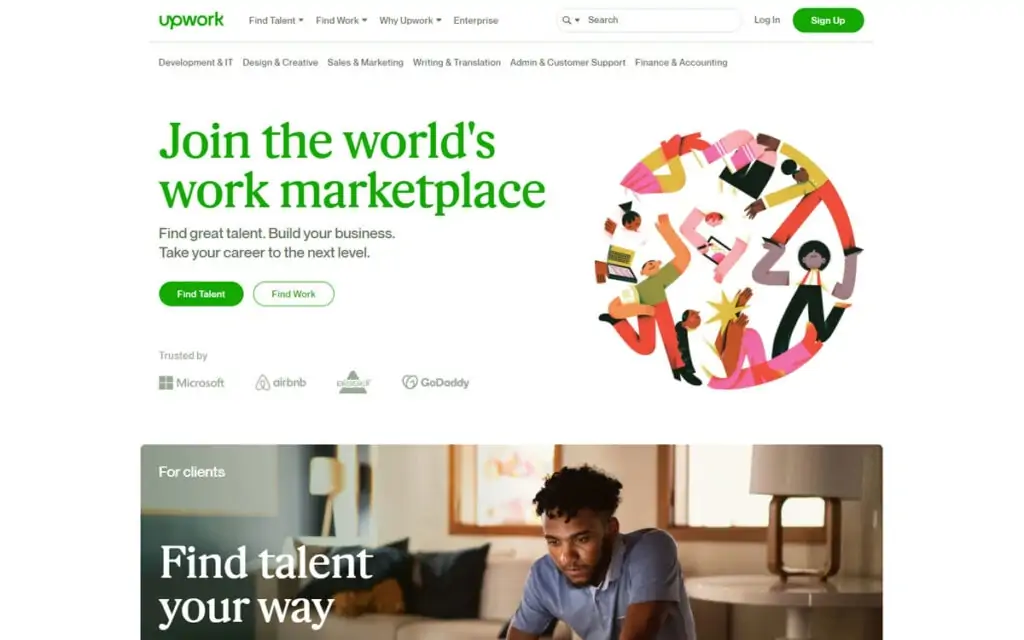
Starting a graphic design business as a beginner can be daunting, but finding clients is an essential first step. Instead of cold calling or networking, a great way to get your first clients is by applying to graphic design jobs posted on job boards. Many job boards are out there, so focus on a few reputable ones catering to graphic designers.
Some of the top job boards for new freelance graphic designers include:
- Upwork – This global freelance marketplace posts countless graphic design jobs daily across diverse industries. You can browse by category and apply to those you're qualified for.
- Fiverr – Fiverr has become a go-to for affordable freelance services. There is a high demand for graphic designers to provide logos, illustrations, social media posts, and more. The jobs tend to be quick turnaround, but it's a volume game.
- Behance – Adobe's Behance network is popular among graphic designers. Companies post available graphic design contracts, and you can directly apply through your portfolio. It's great exposure.
- Freelancer – On Freelancer.com, you can search for graphic design jobs by speciality, from branding to marketing materials. Flexible full-time or part-time contracts are available.
- Local Facebook Groups – Pay attention to local Facebook Groups related to small businesses and creative services. Many entrepreneurs on there source graphic designers.
Creating profiles on these job boards listing your skills and portfolio pieces is critical. Then apply to any appealing graphic design gigs that you're qualified for. It's an effective way for new freelancers to gain experience and build their client roster.
2 – Let your work speak for itself
In addition to showcasing your portfolio on popular creative websites like Dribbble and Behance, establishing your professional freelance website can be invaluable for presenting yourself as an expert in your field. Your website serves as a hub to direct potential clients, allowing you to control the narrative and highlight your best work.
Creating compelling case studies on your site can attract clients by demonstrating your ability to solve real-world problems. Research shows that 65% of B2B companies find case studies more effective for content marketing than other formats like blog posts, videos, and infographics. The reason is that case studies prove through specific examples that you can achieve client results.
A great example of the effective use of case studies is the web development agency PixelCrayons. Their website contains a “Work” page that presents nicely designed case studies of previous projects. Each study outlines the client's needs, PixelCrayon's solution and approach, and the successful results delivered. This provides concrete social proof of their development skills beyond just showing finished products.
Implementing case studies like this can significantly boost your credibility and increase interest from potential new clients. They allow you to walk through your creative process, challenges, and the strategically crafted solution you devised. In an increasingly competitive freelance environment, showcasing your previous successful work in this narrative way can give you a significant advantage over other designers and creative professionals.
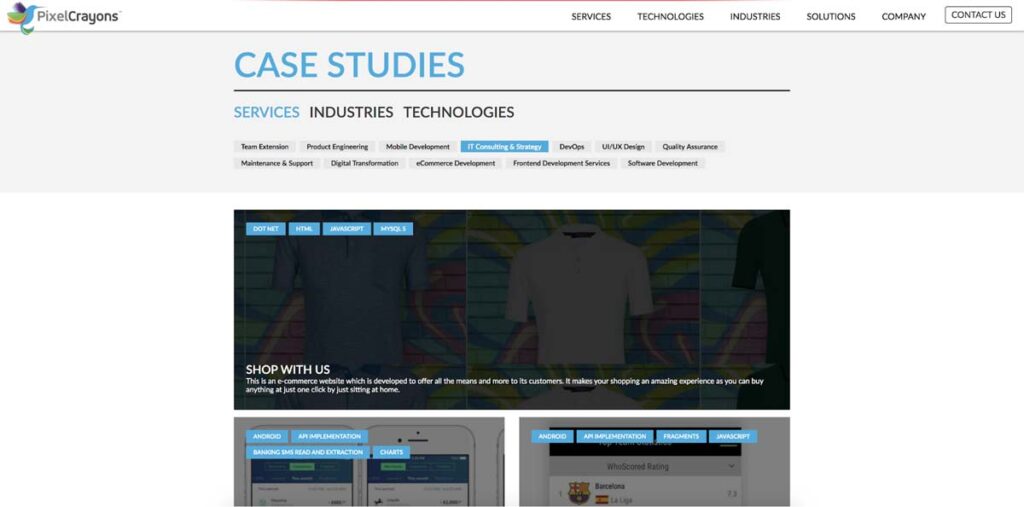
3 – Add a blog to your website
Adding a blog to your website can significantly boost traffic and attract potential clients. However, more than simply having a blog is required – you need a strategic approach to blogging targeting your ideal audience.
Many freelancers make the mistake of only writing about their services or industry. For example, a graphic designer may write posts like “10 Tips for Graphic Designers” or “How to Find Freelance Graphic Design Work.” While informative, this content only attracts other graphic designers rather than potential clients.
Instead, your blog content should target your ideal client's interests, challenges, and questions. Put yourself in their shoes – what information would be valuable to them? Focus on creating content that provides your target audience with solutions, insights and ideas.
For example, if you're a freelance web developer targeting small business owners, you could write posts like “10 Ways to Make Your Website More User-Friendly” or “7 Web Design Trends to Follow in 2023.” Educational, actionable content like this attracts your ideal clients by addressing their needs.
Once you have great content, use calls-to-action at the end of each post to convert readers into leads. Offer a free guide, checklist, or other “lead magnet” in exchange for their email address. This allows you to build an email list and nurture leads by sending helpful follow-up emails after they opt-in.
A great example of effective lead magnets is Modest Money, which includes opt-in forms and free downloads on each of their posts. This technique continually grows their email subscriber list.
A strategic blogging strategy is crucial for attracting your ideal clients. Focus on creating value for your target audience rather than just promoting yourself. Combine educational content with lead magnets to convert website visitors into leads. With this approach, your blog will become a powerful asset for growing your business.

4 – Sell your graphic designs online
Selling your graphic designs online opens up various opportunities to promote your work and build your brand. One strategy requires people to credit you when they use your designs. For example, you could ask buyers to include a statement like “Design by [Your Name/Business]” at the bottom of any project where they use your graphics.
This helps create backlinks and brand awareness as your name circulates on other websites and platforms. Over time, this can significantly boost your SEO and visibility. Potential new clients may come across your credit on a blog, social media post, or other website, which leads them to learn more about you.
In addition to digital files, you can sell physical products like t-shirts, mugs, and calendars featuring your designs. When shipping these items, include a QR code on the packaging or product tag that goes directly to your professional website or online portfolio. This provides an instant portal for customers to discover more of your work and contact you for custom projects.
Selling through established online marketplaces like CreativeMarket makes your work discoverable to millions of users without needing to build your ecommerce platform. You can earn passive income from your portfolio of designs through these sites. And you still have the option to drive customers to your website or channels through your branding and QR codes.
Overall, marketing your graphic designs online creates opportunities to earn income and organically promote your business. By requiring credits and using QR codes, you can leverage your work to build awareness and access for your brand across the web.
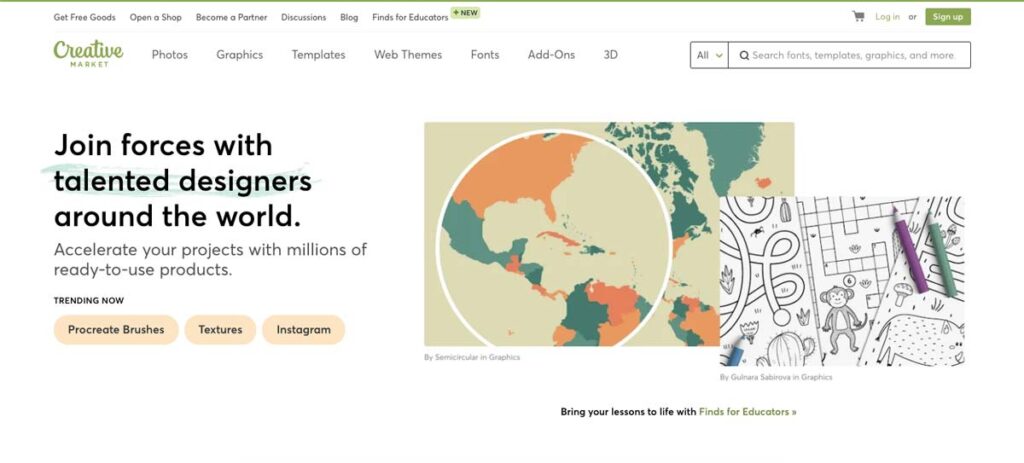
Marketplaces like Creative Market and 99Designs are great options for selling creative assets like design templates, illustrations, photography and more. You can upload your work to these sites and set your prices. The sites handle promotion and facilitate the transactions, taking a commission. This allows you to reach a large audience of buyers looking for creative content.
Design Cuts specialises more in discount deals on design assets, so it may not be the best fit if you want to maximise your earnings per piece. But it can help you move volume and build an audience.
Beyond marketplaces, you can also monetise your work by offering it on your website or blog. A great approach is to create valuable, shareable infographics, templates, guides or other assets related to your niche. For example, Music Oomph created an impressive infographic on podcasting statistics, providing value to their target audience. By allowing visitors to embed or share the image, they benefit from broader exposure and links to their site.
The key is crafting visually compelling, informative assets that readers will want to share. Ensure they are branded and have a clear call-to-action driving traffic back to your site or sales pages.
You can also provide some content for free but offer extended versions, source files or commercial licenses for sale to generate revenue. Providing a taste gives people a reason to pay for the complete asset.

This has worked wonders for them.
It ranks on the first page of Google for the keyword ‘podcasting statistics’, and the above post has received over 2000 backlinks, according to Ahrefs.
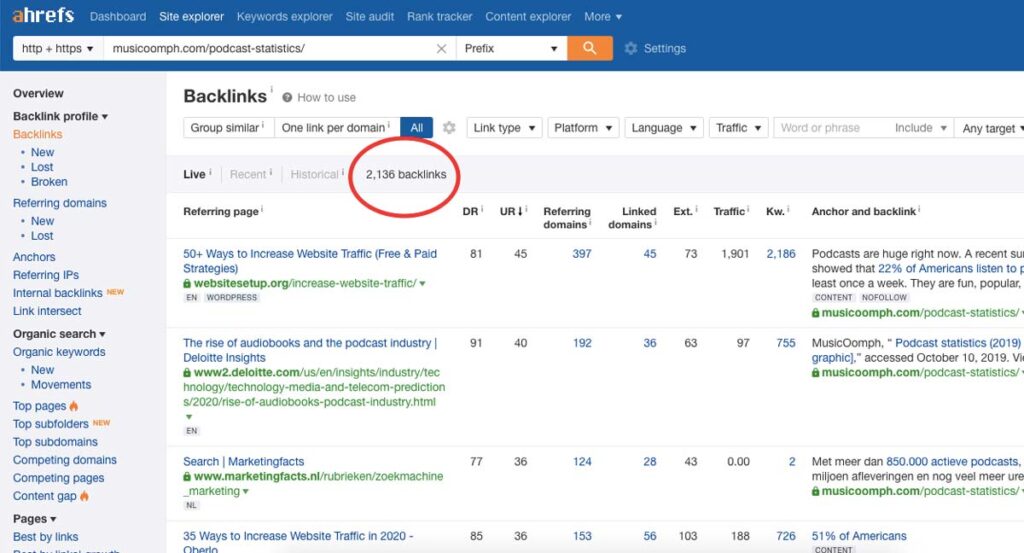
As a graphic designer, you can create compelling infographics that provide value to your audience. For example, you could make an infographic exploring statistics and trends in the graphic design industry. What is the average salary for graphic designers? What software do professionals rely on most? How can an effective logo improve a business's success? What is the typical visual design budget for small companies?
You position yourself as an expert by creating an informative, visually engaging infographic on topics that matter to your audience. If an infographic like this gets consistent daily traffic and engagement, it will attract potential clients. Quality content demonstrates your skills and establishes you as a thought leader. When you consistently provide value through your work, you build trust and gain customers' interest in your services.
The goal is to create content that informs and benefits your target audience. An infographic that offers insightful statistics and advice could attract consistent viewership and spur genuine interest in your services as a graphic designer. You can build authority and gain more clients by publishing engaging, helpful infographics.
5 – Cold Emails are NOT dead
Connecting with potential clients through cold email can be an effective strategy for freelance graphic designers looking to grow their business. Rather than waiting for leads to come to you, taking the initiative to introduce yourself allows you to seek out new work opportunities proactively.
When crafted thoughtfully, cold emails can capture attention and convey your brand. The key is to make your messages concise, personalised, and compelling. Highlight relevant work samples that indicate you can solve their design needs.
If you're looking to build your freelance graphic design career, consider testing cold emails with these steps:
Step 1 – Find Potential Clients
As you refine your list of prospective clients to contact, focus on those you can envision collaborating with successfully. For instance, traditionalist organisations may not be a fit if you specialise in and prefer crafting bold, contemporary designs.
Seek out clients whose creative approach and values align with yours. Identify companies that appeal to you and whose work culture mirrors your own.
Once you've compiled a shortlist of businesses you're genuinely enthusiastic about partnering with, you can reach out. The key is targeting organisations likely to share your perspective and priorities, not just contacting any potential client. This sets the stage for rewarding, harmonious working relationships.
Step 2 – Use hunter.io to find their email addresses
Connecting with the right person at a company you want to work with is critical. Avoid sending a generic email to their support address – it will likely be overlooked. Please do some research to identify the department leader you want to collaborate with, whether it's graphic design, content creation, etc.
Use a free tool like Hunter.io to find contact info for that decision-maker. Reaching out directly with a personalised email will give you a better chance at getting their attention and securing an opportunity to partner. The extra effort to connect with the relevant contact goes a long way.
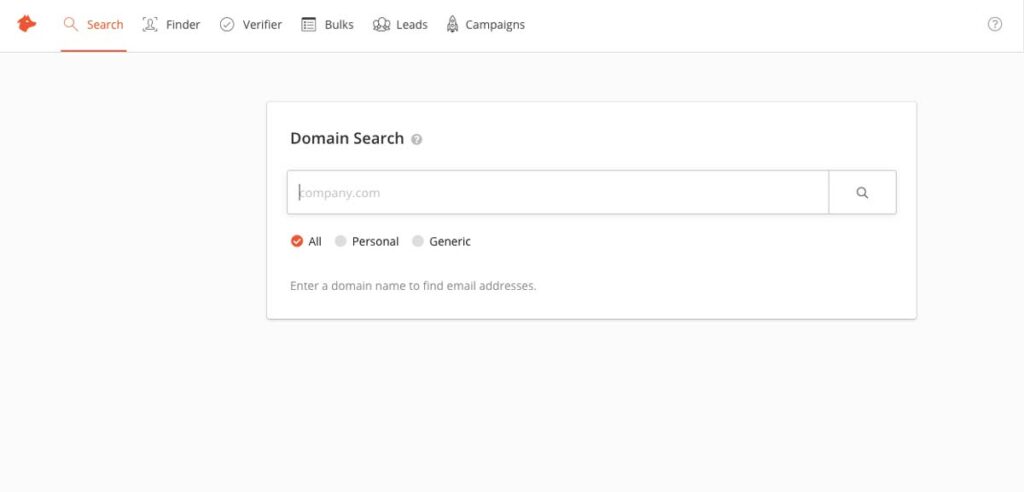
Step 3 – Use a great email template and personalise it every time
Do you need help to get your cold emails opened and generate conversions? It's likely because your outreach messages are too generic and impersonal. But you can dramatically improve your email response rates with some simple tweaks.
The key is personalisation and writing compelling copy. Avoid spraying and praying with a single templated message. Instead, research each prospect beforehand and highlight their pain points in your email. Use their name, company, and role to make it feel tailored. Share relevant case studies or testimonials that relate to their industry and interests.
Craft attention-grabbing yet professional subject lines. Aim for 50 characters or less using power words like “results,” “proven,” or “introducing.” Structure your email in an easy-to-scan format with short paragraphs and plenty of white space. Get to the point quickly and focus on how you can solve their challenges.
With a more strategic and personalised approach, your cold emails will stand out and drive more opens and conversions. Keep going even if your current outreach isn't working. Apply these tips to create emails that get read and generate real business.
Before you start sending emails out, create an excellent template for yourself. Here is a good example.
Subject: Bringing your brand vision to life with award-winning design
Dear [Client Name],
I hope this email finds you well! My name is [Your Name] and I'm an award-winning graphic designer specializing in branding and visual identity.
I came across [Client Company] while researching local businesses, and I was immediately impressed with the work you're doing in the [Client Industry] space. Your commitment to [Client Mission/Values] really resonates with me.
I would love to offer my services to help take [Client Company's] branding and marketing materials to the next level. With over [X] years in the design industry, I have a proven track record of creating eye-catching and effective visuals that connect with target audiences and get results.
My design expertise includes:
Logo design
Brand guide creation
Print collateral (business cards, letterhead, brochures)
Web design
Social media graphics
Packaging
I work with clients big and small, from startups to Fortune 500 companies. Some of my recent clients include [Impressive Client Names].
I would welcome the opportunity to learn more about your branding needs and discuss how I can help elevate [Client Company's] visual identity. Please let me know if you would be open to jumping on a quick phone call to go over what you're looking for in a graphic designer.
I look forward to potentially working together!
Best,
[Your Name]
[Your Website]
[Your Phone Number]Conclusion on How to Get Graphic Design Clients
Running a successful freelance graphic design business is like maintaining a well-oiled machine – once you have established a steady stream of clients, the momentum can keep things moving smoothly. However, getting to that point takes strategic effort and perseverance.
Implementing tactics like networking, referrals, promotions, social media presence, and client nurturing is essential to attracting those first few critical clients and proving your skills. Building relationships and trust is at the core of freelancing. It's about more than having raw talent – you must convince potential clients that you understand their needs and can deliver real value.
Approaching the right people and organisations that align with your services and communicating how you can help them meet their goals is critical. Back this up by highlighting relevant work samples and testimonials that showcase your abilities. Be persistent and patient – securing those initial projects is social proof that you are a worthwhile investment.
Once you have a few regular clients, focus on over-delivering work and fostering lasting connections. Check-in regularly, ask for feedback, and tell people you appreciate their business. A portfolio of satisfied clients leads to referrals and more stable work. Maintain your momentum by networking, advertising, and keeping your skills sharp. Consistent excellence keeps the wheels turning.
While it takes effort to get there, with the right strategy and commitment, a freelance design business can operate like a fine-tuned machine. Satisfied clients are the fuel that keeps things running smoothly.
